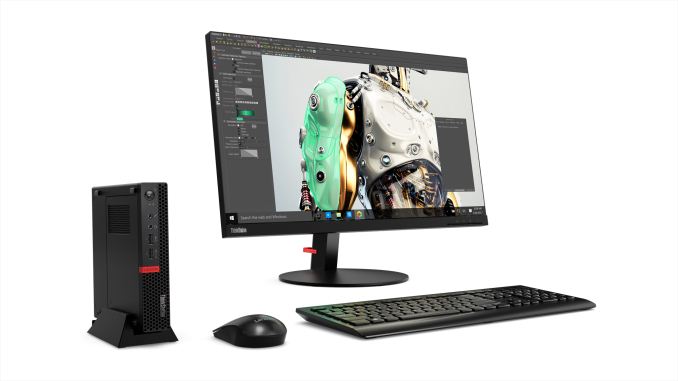Lenovo Unveils ThinkStation P320 Tiny SFF Workstation
by Ganesh T S on June 20, 2017 10:20 AM EST- Posted in
- Systems
- Intel
- Lenovo
- Quadro
- Workstation
- SFF
- NVIDIA
- Pascal
- ThinkStation
- Kaby Lake

Lenovo has unveiled a new ThinkStation model, the P320 Tiny, based on a Kaby Lake / Q270 platform with NVIDIA's Quadro P600 GPU. The unique aspect is the dimensions - At 1.4" x 7.1" x 7.2" (1L in volume), it is one of the smallest systems we have see that includes a discrete GPU. In order to achieve this compact size, the 135W power adapter is external to the system.
The P320 Tiny supports Kaby Lake CPUs with TDP of up to 35W (such as the Intel Core i7-7700T). NVIDIA's Quadro P600 is a GP107-based GPU with a 40W TDP. The system comes with two DDR4 SODIMM slots and two M.2 NVMe SSD slots. There is a rich variety of I/O ports - audio jacks in the front, a total of six USB 3.0 ports spread across the front and the rear, a RJ-45 GbE port, and six display outputs (4x mini-DP + 2x DP). Thanks to the Quadro GPU, the P320 Tiny is able to come with ISV certifications for various applications such as AutoCAD etc.
| Lenovo ThinkStation P320 Tiny: General Specifications | |||
| CPU | Intel Kaby Lake (up to Core i7) (35W TDP max.) |
||
| Chipset | Intel Q270 | ||
| RAM | Up to 32 GB DDR4-2400 (2x SODIMM) | ||
| GPU | NVIDIA Quadro P600 | ||
| Storage | 2x M.2 PCIe: up to 1 TB NVMe SSD each ODD: optional with add-on |
||
| Networking | Gigabit Ethernet Intel 802.11 ac, 2 x 2, 2.4 GHz/5GHz + Bluetooth 4.0 - |
||
| I/O | 6x USB 3.0 Serial - optional |
||
| Dimensions | 1.4" x 7.1" x 7.2" | ||
| Weight | 2.9 lbs | ||
The board used in the system seems to be a custom one - it is larger than a mini-STX board, but, smaller than an ITX one. It is perfect for space-constrained setups, and comes with extensibility options such as add-ons for extra USB ports and a COM port, or, for an optical drive, as shown in the gallery below.
As for operating systems, the new Lenovo ThinkStation P320 Tiny workstation supports both Windows and Linux. The P320 Tiny starts at $799 and is available now.

















26 Comments
View All Comments
HeyEric - Wednesday, June 21, 2017 - link
Entry workstation. It is an ENTRY workstation because it is certified to run specific (primarily single-threaded) workstation applications. ECC memory, while recommended, is not mandatory, nor is it even the majority share of memory in the entry space.CaedenV - Saturday, June 24, 2017 - link
It depends on what you mean by workstation.If by workstation you mean a station where you do work (office, school, retail, etc) then this is a perfectly applicable device.
If by workstation you mean a work-horse server being used as an end-user device, then no, this is not for you. It is a glorified laptop meant to stay in one place. You aren't going to be running solid works or other high compute programs on this thing.... they couldn't do it even if you wanted them to. But such workstations are not going to be so tiny either.
mobutu - Tuesday, June 20, 2017 - link
I like this, nice. Hopefully it stays relatively cool and quiet.Ej24 - Tuesday, June 20, 2017 - link
A coworker has the Dell iteration of this and it's dead silent. It's the size of a paperback book with a real quad-core i7. What more could you ask for?mobutu - Tuesday, June 20, 2017 - link
That's very very good to hear, thanks!Also, these guys updated their article with the info that the price starts at $799
https://www.neowin.net/news/lenovo-announces-the-t...
CaedenV - Saturday, June 24, 2017 - link
So, I am no fan of Lenovo. Outside of a few high-end laptops I find most of their products to be disappointing.That said, the school district I work for bought the previous gen of these mini-desktops last year and they worked out rather well. They are cute, small, quiet, and ours (i5 with SSDs) were nice and quick. Very happy and would purchase again. But the best part is that they don't seem to compromise on port selection like Intel NUC devices do. Where our NUC devices have 3-4 USB ports and 2 video outs, these have 6-8 USB, 3 video out options, audio jack, ethernet, wifi (w/ antenna), etc. I would still use a NUC for my wife's next PC. But in a school or business where a device is more likely to be thrown in different environments and use cases over it's life as programs change I would absolutely pick something like these again to keep options more open.